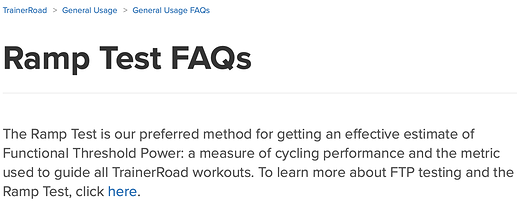Dear all,
I hereby wish to share my experiences using TrainerRoad. My goal is to contribute something to this community. I would love to acquire more knowledge about my physical condition and training in general.
First, we’ll start off by taking you back to March 2019:
I went to a sports medical institute to perform a cycling lactate threshold test. The test protocol consisted of a ramp increasing by 50 watts every 3 minutes. The test ended at 350W, 18m30s after starting and ending with a blood lactate level of 16.3 mmol. FTP: 240W (derived from the best 1-minute power)
The accompanying counselor summarized the results and catergorized me as being a classic ‘weekend warrior’. I. e. cyclists who hardly train during weekdays and go too hard on weekend group rides. Otherwise stated: cyclists that hardly ever spend time in the endurance zone and mostly train their bodies in the ‘higher’ zones. During these lactate threshold tests the lactate blood levels of the so-called ‘weekend warriors’ rise relatively quickly as their aerobic base fitness isn’t that good.
Reflecting back to myself we were only to conclude my base fitness wasn’t well trained and I relied heavily on my anaerobic capacities during this test as my max blood lactate level was exceptionally high.
Fast forward to September 2019:
Me purchasing my first indoor trainer (Wahoo Kickr). FTP: 232W after performing the Zwift ramp test and thereafter commenced with a a 6-week zwift training plan.
November 2019: Crash and burn!
I managed to complete the 6-week Zwift training plan but without any recovery week in between this really broke me, physically and mentally! The following weeks I was fatigued and lacked motivation to train any further. Instead I tried to just have fun by doing outside rides and on Zwift by joining group rides and some unstructured workouts.
March 2020: Off to a new start, TR-time!
My first TrainerRoad ramp test: FTP 224W. I embark on a low volume plan.
April 2020: Gains!
TrainerRoad ramp test result: FTP 239W (6% increase)
At that time the workouts already felt pretty though. A 6% FTP increase is nice but the zones increase by 6% as well. Each workout my heart rate would eventually go into the anaerobic zone while only doing sweet spot work and an occasional VO2max workout.
May 2020: More gains!
TrainerRoad ramp test result: FTP 254W (6% increase)
After this ramp test I commenced with a build phase which consisted of threshold work versus sweet spot work in the previous base phase. This combined with the 6% FTP increase meant that I suddenly had to ride 10-minute intervals at 16% above the sweet spot work of the previous phase.
By that time I could barely hang on during workouts and I would fail to finish every single workout.
June 2020: Crash and burn (again)!
TrainerRoad ramp test result: FTP 230W (10% decrease)
Mentally and physically drained I cancelled my TrainerRoad subscription and during the next months I stayed away from any form of structured training.
September 2020: back to Zwift
Zwift ramp test result: FTP 256W (all-time high) (Zwift ramps up quicker with 20W steps instead of 15W in my TrainerRoad ramp test)
At the time I was very suprised by the result. I had stayed away from any structured training the previous 3 months and I still managed to break all previous FTP results.
The next period of time, I did some sweet spot workouts combined with outdoor rides but no real structure.
December 2020: To ramp test or not to ramp test, that is the question.
Looking back at the past year of indoor training I must admit that I am a bit disappointed. All the hard workouts barely paid off as I overreached myself at least 2 times.
So I start to think: “What is FTP? FTP is the measure of power you can hold for one hour.”
Then it struck me, never in the past year I would have been able to maintain my FTP wattage for an hour. I know this for a fact because I even struggled to complete sweet spot workouts with intervals at 90% of my so-called FTP.
So very recently I executed the Zwift 20-minute ramp test. You start off with some sprints and a 5 minute effort above threshold to drain the anaerobic tank and thereafter you go all out for 20 minutes.
The results: 231W over 20 minutes. If you calculate FTP you multiply this value by 0.95: new FTP is 221W.
Could it be that over the past year my ramp test results where a gross overestimation of my FTP?
Could that be true because I am an ‘anaerobically stronger’ rider and during the 1 minute in which the ramp test determines your result I happen to excel because of my capability to cope with high lactate blood levels?
FTP should be the result of a 1-hour ‘aerobic’ effort but me doing ramp test probably gives me different results? In fact 13 % off if you would compare my 20-minute test with the September ramp test of 256W.
My last sweet spot workouts went really well and my heart rate usually stays in my tempo heart rate zones.
If you are still reading by now I would very curious to read your thoughts and advice on my story. Any misassumptions I made or experiences of your own. I would be glad to read and learn about them.
Thanks in advance!
Kind regards,
A fellow cyclist fanatic,
Gurbe
male, age: 30, weight: 69kgs



